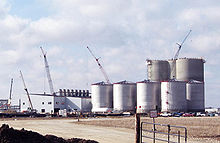The economy of Gibraltar consists largely of the services sector. While part of the European Union until Brexit, the British overseas territory of Gibraltar has a separate legal jurisdiction from the United Kingdom and a different tax system. The role of the UK Ministry of Defence, which at one time was Gibraltar's main source of income, has declined, with today's economy mainly based on shipping, tourism, financial services, and the Internet.

Gross domestic product (GDP) is a monetary measure of the market value of all the final goods and services produced in a specific time period by a country or countries. GDP is most often used by the government of a single country to measure its economic health. Due to its complex and subjective nature, this measure is often revised before being considered a reliable indicator.
A variety of measures of national income and output are used in economics to estimate total economic activity in a country or region, including gross domestic product (GDP), gross national product (GNP), net national income (NNI), and adjusted national income. All are specially concerned with counting the total amount of goods and services produced within the economy and by various sectors. The boundary is usually defined by geography or citizenship, and it is also defined as the total income of the nation and also restrict the goods and services that are counted. For instance, some measures count only goods & services that are exchanged for money, excluding bartered goods, while other measures may attempt to include bartered goods by imputing monetary values to them.

Agricultural productivity is measured as the ratio of agricultural outputs to inputs. While individual products are usually measured by weight, which is known as crop yield, varying products make measuring overall agricultural output difficult. Therefore, agricultural productivity is usually measured as the market value of the final output. This productivity can be compared to many different types of inputs such as labour or land. Such comparisons are called partial measures of productivity.

Agriculture is a major industry in the United States, which is a net exporter of food. As of the 2017 census of agriculture, there were 2.04 million farms, covering an area of 900 million acres (1,400,000 sq mi), an average of 441 acres per farm.

The economy of Illinois is the fifth largest by GDP in the United States and one of the most diversified economies in the world. Fueled by the economy of Chicago, the Chicago metropolitan area is home to many of the United States' largest companies, including Abbott Laboratories, AbbVie Inc., Allstate, Baxter International, Conagra, Crate and Barrel, Kraft Heinz, McDonald's, CNH Industrial, GE Healthcare, Aon PLC, Willis Towers Watson, Mondelez International, Motorola, United Airlines, US Foods, Walgreens, and more. The Chicago area is a global financial center and headquarters a wide variety of financial institutions including Citadel LLC, CNA Financial, Discover Financial Services, Morningstar, Inc., Nuveen, and more. Chicago is also home to the largest futures exchange in the world, the Chicago Mercantile Exchange.
In economics, gross value added (GVA) is the measure of the value of goods and services produced in an area, industry or sector of an economy. "Gross value added is the value of output minus the value of intermediate consumption; it is a measure of the contribution to GDP made by an individual producer, industry or sector; gross value added is the source from which the primary incomes of the System of National Accounts (SNA) are generated and is therefore carried forward into the primary distribution of income account."
Production is the process of combining various inputs, both material and immaterial in order to create output. Ideally this output will be a good or service which has value and contributes to the utility of individuals. The area of economics that focuses on production is called production theory, and it is closely related to the consumption theory of economics.

For millennia, agriculture has played an important role in the Chinese economy and society. By the time the People's Republic of China was established in 1949, virtually all arable land was under cultivation; irrigation and drainage systems constructed centuries earlier and intensive farming practices already produced relatively high yields. But little prime virgin land was available to support population growth and economic development. However, after a decline in production as a result of the Great Leap Forward (1958–60), agricultural reforms implemented in the 1980s increased yields and promised even greater future production from existing cultivated land.

Agriculture in Ethiopia is the foundation of the country's economy, accounting for half of gross domestic product (GDP), 83.9% of exports, and 80% of total employment.
There are various social, economic, environmental and technical issues with biofuel production and use, which have been discussed in the popular media and scientific journals. These include: the effect of moderating oil prices, the "food vs fuel" debate, poverty reduction potential, carbon emissions levels, sustainable biofuel production, deforestation and soil erosion, loss of biodiversity, effect on water resources, the possible modifications necessary to run the engine on biofuel, as well as energy balance and efficiency. The International Resource Panel, which provides independent scientific assessments and expert advice on a variety of resource-related themes, assessed the issues relating to biofuel use in its first report Towards sustainable production and use of resources: Assessing Biofuels. In it, it outlined the wider and interrelated factors that need to be considered when deciding on the relative merits of pursuing one biofuel over another. It concluded that not all biofuels perform equally in terms of their effect on climate, energy security and ecosystems, and suggested that environmental and social effects need to be assessed throughout the entire life-cycle.
An economic impact analysis (EIA) examines the effect of an event on the economy in a specified area, ranging from a single neighborhood to the entire globe. It usually measures changes in business revenue, business profits, personal wages, and/or jobs. The economic event analyzed can include implementation of a new policy or project, or may simply be the presence of a business or organization. An economic impact analysis is commonly conducted when there is public concern about the potential impacts of a proposed project or policy.

Moldova is an agrarian-industrial state, with agricultural land occupying 2,499,000 hectares in a total area of 3,384,600 hectares. It is estimated that 1,810,500 of these hectares are arable. Moldova is located in Eastern Europe, and is landlocked, bordering Romania and Ukraine. Moldova's agricultural sector benefits from a geographical proximity to large markets, namely the European Union. As a share of GDP, agriculture has declined from 56% in 1995 to 13.8% in 2013. Data from 2015 estimated that agriculture accounted for 12% of Moldova's GDP. Agriculture as a sector is export-oriented, with the composition of Moldova's total exports containing agriculture and the agri-food sector as a main component. 70% of agri-food exports in 2012 included beverages, edible fruits and nuts, oilseeds, vegetable preparations and cereals. Here, fruits, vegetables and nuts were attributed to 33% of Moldova's exports for 2011–2013. Moldova is also one of the top ten apple exporters in the world. However, because of the long-term emphasis on fruit, vegetables are often imported.
In the agricultural context, diversification can be regarded as the re-allocation of some of a farm's productive resources, such as land, capital, farm equipment and labour to other products and, particularly in richer countries, to non-farming activities such as restaurants and shops. Factors leading to decisions to diversify are many, but include: reducing risk, responding to changing consumer demands or changing government policy, responding to external shocks and, more recently, as a consequence of climate change.

Iowa is a state in the upper Midwestern region of the United States, bordered by the Mississippi River to the east and the Missouri River and Big Sioux River to the west. It is bordered by six states: Wisconsin to the northeast, Illinois to the east and southeast, Missouri to the south, Nebraska to the west, South Dakota to the northwest, and Minnesota to the north.

Manufacturing is a vital economic sector in the United States. The United States is the world's third largest manufacturer with a record high real output in Q1 2018 of $2.00 trillion well above the 2007 peak before the Great Recession of $1.95 trillion. The U.S. manufacturing industry employed 12.35 million people in December 2016 and 12.56 million in December 2017, an increase of 207,000 or 1.7%. Though still a large part of the US economy, in Q1 2018 manufacturing contributed less to GDP than the 'Finance, insurance, real estate, rental, and leasing' sector, the 'Government' sector, or 'Professional and business services' sector.

The production of corn plays a major role in the economy of the United States. The US is the largest corn producer in the world, with 96,000,000 acres (39,000,000 ha) of land reserved for corn production. Corn growth is dominated by west/north central Iowa and east central Illinois. Approximately 13% of its annual yield is exported.
Socially necessary labour time in Marx's critique of political economy is what regulates the exchange value of commodities in trade and consequently constrains producers in their attempt to economise on labour. It does not 'guide' them, as it can only be determined after the event and is thus inaccessible to forward planning.
Farmers' markets are markets in which producers sell directly to consumers. While farmers' markets do not have a measurable impact on the United States economy as a whole, many studies have found that farmers' markets impact state and municipal economies as well as vendors, local businesses, and consumers. These impacts are measured using the IMPLAN Input-Output Model and the Sticky Economic Evaluation Device (SEED), in addition to other methods. The economic impacts that are most frequently measured include effects on the revenue and income of local growers and local businesses, the effects on job creation, and the effects on other sectors of state and local economies. Some obstacles that may reduce impact or create negative economic effects include over-saturation, socioeconomic barriers, the opportunity cost of farmers' markets, and the projected unsustainable growth of farmers' markets in the United States.
Kentucky is an agricultural producer in the United States. Value of agricultural products was $5 billion in 2012, of which slightly less than half was crops. Crops grown in the state include corn, soybeans, hay, wheat and tobacco. Historically, hemp has been a cash crop in the state. Finished agricultural products produced in the state include Kentucky bourbon and Kentucky wine.



















